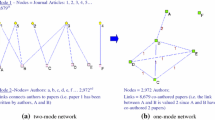Abstract
With an increase in studies of actors’ collaborative activities on their performance very few have examined the role of the structural influence of actors on their cohorts’ performance. In this study, we argue that the collaborative process involves social influence and social capital embedded within relationships and network structures amongst direct partner. We examine whether such influence is directly associated with an actor’s productivity and performance. In particular, we aim to understand how structural position of an actor’s cohorts and their structural and power diversity in a network influence the productivity and performance. Network-based centrality measures are used to evaluate the structural position. To investigate how partners of an actor in a collaboration network can influence their productivity and/or performance, we evaluate their structural diversity in the network by measuring the variance of their centrality measures. We evaluate if the variance of centrality measures of partners of a scholar influence their productivity or performance.


Similar content being viewed by others
References
Abbasi, A. (2013). h-Type hybrid centrality measures for weighted networks. Scientometrics, 96(2), 633–640.
Abbasi, A., Altmann, J., & Hossain, L. (2011). Identifying the effects of co-authorship networks on the performance of scholars: A correlation and regression analysis of performance measures and social network analysis measures. Journal of Informetrics, 5(4), 594–607.
Abbasi, A., Altmann, J., & Hwang, J. (2010). Evaluating scholars based on their academic collaboration activities: Two indices, the RC-index and the CC-index, for quantifying collaboration activities of researchers and scientific communities. Scientometrics, 83(1), 1–13.
Abbasi, A., & Hossain, L. (2013). Hybrid centrality measures for binary and weighted networks. In R. Menezes, A. Evsukoff, & M. C. González (Eds.), Complex networks (Vol. 424, pp. 1–7). Berlin: Springer.
Abbasi, A., & Jaafari, A. (2013). Research impact and scholars’ geographical diversity. Journal of Informetrics, 7(3), 683–692.
Abbasi, A., Wigand, R., & Hossain, L. (2014). Measuring social capital and its influence on individual performance. Library & Information Science Research, 36(1), 66–73.
Abramo, G., & D’Angelo, C. A. (2016). A farewell to the MNCS and like size-independent indicators. Journal of Informetrics, 10(2), 646–651.
Barabási, A.-L. (2013). Network science. Philosophical Transactions of the Royal Society A, 371, 20120375.
Bavelas, A. (1950). Communication patterns in task-oriented groups. Journal of the Acoustical Society of America, 22, 725–730.
Borgatti, S. (1995). Centrality and AIDS. Connections, 18(1), 112–114.
Crandall, D., Cosley, D., Huttenlocher, D., Kleinberg, J., & Suri, S. (2008). Feedback effects between similarity and social influence in online communities. New York: ACM.
Demsetz, H. (1991). The theory of the firm revisited. In O. E. Williamson, S. G. Winter, & R. H. Coase (Eds.), The nature of the firm: Origins, evolution, and development (pp. 159–179). New York: Oxford University Press.
Freeman, L. C. (1979). Centrality in social networks conceptual clarification. Social Networks, 1(3), 215–239.
Freeman, L. C. (1980). The gatekeeper, pair-dependency and structural centrality. Quality & Quantity, 14(4), 585–592.
Friedkin, N. E. (1998). A structural theory of social influence. Cambridge: Cambridge University Press.
Haque, A., & Ginsparg, P. (2009). Positional effects on citation and readership in arXiv. Journal of the American Society for Information Science and Technology, 60(11), 2203–2218.
Hirsch, J. E. (2005). An index to quantify an individual’s scientific research output. Proceedings of the National Academy of Sciences of the USA, 102(46), 16569–16572.
Imran, M., Elbassuoni, S. M., Castillo, C., Diaz, F., & Meier, P. (2013). Extracting information nuggets from disaster-related messages in social media. Baden-Baden: ISCRAM.
Jalili, M., Orouskhani, Y., Asgari, M., Alipourfard, N., & Perc, M. (2017). Link prediction in multilayer online social networks. Royal Society Open Science, 4(2), 160863.
Jalili, M., & Perc, M. (2017). Information cascades in complex networks. Journal of Complex Networks, 5(5), 665–693.
Javari, A., & Jalili, M. (2015). A probabilistic model to resolve diversity-accuracy challenge of recommendation systems. Knowledge and Information Systems, 44, 609–627.
Jiang, Y. (2008). Locating active actors in the scientific collaboration communities based on interaction topology analyses. Scientometrics, 74(3), 471–482.
Lü, L., & Zhou, T. (2011). Link prediction in complex networks: A survey. Physica A, 390, 1150–1170.
Peng, S., Wang, G., & Xie, D. (2017). Social influence analysis in social networking big data: Opportunities and challenges. IEEE Network, 31(1), 11–17.
Saarela, M., Kärkkäinen, T., Lahtonen, T., & Rossi, T. (2016). Expert-based versus citation-based ranking of scholarly and scientific publication channels. Journal of Informetrics, 10(3), 693–718.
Sabidussi, G. (1966). The centrality index of a graph. Psychometrika, 31(4), 581–603.
Scott, J. (1991). Social network analysis: A handbook. Beverley Hills: Sage.
Shahriari, M., & Jalili, M. (2014). Ranking nodes in signed social networks. Social Network Analysis and Mining, 4(1), 1–12.
Strang, D. (2000). Review: A structural theory of social influence. JSTOR, 45, 162–164.
Takeda, H., Truex III, D., & Cuellar, M. (2010). Evaluating scholarly influence through social network analysis: The next step in evaluating scholarly influence. In AMCIS 2010 proceedings (Vol. 573).
Waltman, L. (2016). A review of the literature on citation impact indicators. Journal of Informetrics, 10(2), 365–391.
Wasserman, S., & Faust, K. (1994). Social network analysis: Methods and applications. Cambridge, NY: Cambridge University Press.
Yan, E., & Ding, Y. (2009). Applying centrality measures to impact analysis: A coauthorship network analysis. Journal of the American Society for Information Science and Technology, 60(10), 2107–2118.
Zhang, C., Lu, T., Chen, S., & Zhang, C. (2017). Integrating ego, homophily, and structural factors to measure user influence in online community. IEEE Transactions on Professional Communication, 60(3), 292–305.
Zhuge, H., & Zhang, J. (2010). Topological centrality and its e-science applications. Journal of the American Society for Information Science and Technology, 61(9), 1824–1841.
Acknowledgements
This research was supported by Korean MSIT (Ministry of Science and ICT) under the ITRC support program (IITP-2017-2016-0-00312) supervised by the IITP.
Author information
Authors and Affiliations
Corresponding author
Rights and permissions
About this article
Cite this article
Abbasi, A., Jalili, M. & Sadeghi-Niaraki, A. Influence of network-based structural and power diversity on research performance. Scientometrics 117, 579–590 (2018). https://doi.org/10.1007/s11192-018-2879-3
Received:
Published:
Issue Date:
DOI: https://doi.org/10.1007/s11192-018-2879-3




